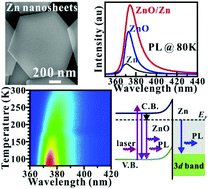Temperature-dependent ultraviolet photoluminescence in hierarchical Zn, ZnO and ZnO/Zn nanostructures†
Abstract
The temperature-dependent effects on the ultraviolet (UV) photoluminescence (PL) enhancement, blueshift, thermal quenching, and chromaticity of the two-dimensional (2D) Zn nanosheets, 2D-hierarchical ZnO nanostructures, and 2D-hierarchical ZnO/Zn nanostructures are presented. In this study, 2D Zn nanosheets were synthesized using a hot-plate metal vapor deposition technique, after which 2D-hierarchical ZnO nanostructures and ZnO/Zn were prepared from the 2D Zn nanosheets by a simple thermal annealing method. The enhancement and blueshift of the UV PL emissions from the three nanostructures at low temperatures arose from three distinct PL mechanisms. For the ZnO nanostructures, the UV PL emission enhancements and blueshifts at low temperature were due to the conversion of the free excitons (FXs) to neutral-donor-bound-excitons (D0Xs). The ZnO/Zn nanostructures possessed the highest UV PL intensities among the three nanostructures, because the free electrons from the Zn portions across the metal–semiconductor heterojunctions greatly assisted in enhancing the PL emissions. The enhancement and thermal quenching were quantitatively analyzed with simple normalization methods. The results show that all three kinds of nanostructures are excellent candidates for use in UV light emitters.



 Please wait while we load your content...
Please wait while we load your content...